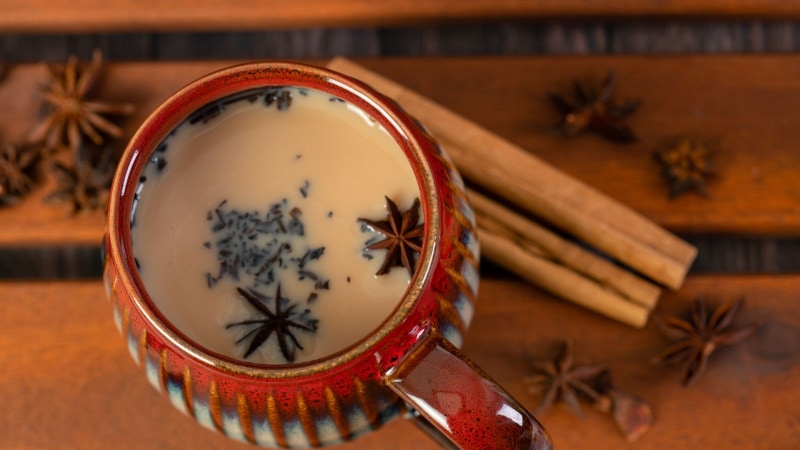Masala Chai, a traditional Indian spiced tea, is a symbol of rich culture and history. This unique blend of black tea, fresh spices and milk combines depth of flavor and health benefits.
Masala Chai – history and traditions
Masala Chai, also known as spiced tea, is not only a drink, but also an important part of culture in many regions, especially in India. Its history dates back thousands of years, when, according to legend, it was created as a medicinal drink within the Ayurvedic tradition. Over time, it has evolved into a popular drink around the world, with its unique taste and aroma attracting more and more enthusiasts.
- Origins in Ayurveda: Masala Chai, like many traditional Indian foods and drinks, has roots in Ayurveda, which is an ancient medical system originating in India. The herbs and spices used in Masala Chai, such as cardamom, cinnamon, ginger, cloves and pepper, were chosen for their health benefits.
- Colonial influences: The history of Masala Chai took a new turn with the arrival of the British in India. The British East India Company, seeking to break the Chinese monopoly on the tea trade, began promoting tea cultivation in India. This in turn led to the development of a unique version of tea, combining local spices with black tea.
- Regional variation: Depending on the region, recipes for Masala Chai can vary widely. Some versions focus on the intensity of the spices, while others may have a milder flavor and be sweeter.
- Modern adaptations: Today, Masala Chai is popular around the world, with various variations available in cafes and restaurants. These adaptations often combine traditional elements with modern ones, creating a variety of flavors that attracts a wide range of foodies.
Masala Chai – recipe
The preparation of Masala Chai is not only the process of brewing tea, but also the art of combining different flavors and aromas. Each step in the preparation of this drink plays a key role in shaping its final character.
- Selection of Ingredients: The basis of Masala Chai is black tea, preferably with a strong flavor, which will be the base for adding a blend of spices. Some of the most popular spices include cardamom, cinnamon, ginger, cloves and black pepper.
- Proportions: the proportions of tea and spices can vary depending on your preference. Usually one part tea to one part spice mixture is used.
- Cooking: The tea and spices are boiled together with water, and then milk is added. It is important that the mixture be simmered to release the deep flavors of the spices.
- Sweetening: Traditionally, sugar is added to Masala Chai, but honey or syrup can also be used, depending on individual preference.
- Serving: The finished Masala Chai should be strained into cups. It can be served either hot or chilled, depending on your preference.
Preparing Masala Chai is the perfect opportunity to experiment with flavors and find your own perfect version of this classic drink.

Masala Chai properties – health benefits
Masala Chai not only delights with its taste, but also offers a number of health benefits, thanks to its ingredients rich in bioactive compounds.
- Strengthening the Immune System: Thanks to the presence of spices such as ginger and cinnamon, Masala Chai helps strengthen the immune system, which is especially important during cold and flu season.
- Digestive Aid: Due to its warming properties and blend of spices, Masala Chai aids digestive processes and helps relieve stomach problems.
- Reducing Inflammation: Ingredients such as ginger and turmeric are known for their anti-inflammatory properties, making Masala Chai a good choice for those suffering from inflammatory conditions.
- Energy and Stimulation: Black tea provides caffeine, which acts as a stimulant and can help improve concentration and increase energy levels.
- Mood Enhancement: The aromatic spices in Masala Chai can help improve mood and overall well-being.
In addition to flavor, Masala Ch ai has many health benefits, making it an excellent choice not only for tea lovers, but also for those who care about their health.
Masala Chai tea – a variety of flavors and variations
Masala Chai tea is known for its incredible variety of flavors and variants. What distinguishes each version is the unique composition of spices and the way it is brewed.
- Regional Variations: In different regions of India and around the world, Masala Chai is prepared in a variety of ways. For example, in some parts of India, stronger and spicier versions are preferred, while in others a sweeter and milder flavor prevails.
- Individual Customization: Masala Chai lovers often experiment with different spice combinations to adjust the flavor to their own preferences. You can increase the amount of ginger for extra heat or add more cinnamon for a sweeter touch.
- Non-Black Leaf Versions: Although traditional Masala Chai is brewed with black tea, there are decaffeinated versions that use green tea or rooibos as an alternative.
- Modern Adaptations: Modern interpretations of Masala Chai are popping up in cafes around the world, incorporating ingredients such as vanilla, mint or even chocolate to create unique flavor combinations.
- Brewing Methods: Traditionally, Masala Chai is brewed by boiling, but there are also fast-brewing methods that preserve the intensity of flavor with less preparation time.
Discovering Masala Chai is a journey through a variety of flavors and aromas, allowing everyone to find their favorite version of this classic drink.
Brewing Masala Chai – secrets of the masters.
Brewing Masala Ch ai is an art that requires patience and intuition. The masters of this drink reveal a few secrets that help you get the perfect flavor and aroma.
- Low Cooking Temperature: One of the keys to a perfect Masala Chai is to cook it over low heat. This allows the flavors and aromas to be slowly released from the spices, without the risk of burning.
- Brewing Time: The brewing time is equally important. Too short will not fully release the flavors, and too long can make the tea bitter. The ideal time is usually around 10 minutes.
- Water to Milk Ratio: The ratio of water to milk can greatly affect the taste and consistency of the tea. Usually an equal amount of water and milk is used, but you can adjust this to suit your preferences.
- Freshness of Ingredients: The freshness of the spices is crucial. It is best to use freshly ground spices, which retain maximum flavor.
- Individual Adjustment: The last and most important secret is individual flavor adjustment. There is no one “correct” way to brew Masala Chai – it’s personal taste and preference that counts.
Brewing Masala Ch ai is a process that can be perfected over time by experimenting with different flavors and methods.
Summary: Masala Chai – recipe, brewing, properties.
This article presented a comprehensive picture of Masala Chai, including its history, recipe, health benefits, variety of flavors and brewing techniques. Here are the main points:
- Masala Chai has its roots in the Ayurvedic medical tradition, and its popularity has grown through colonial influences and regional adaptations.
- The recipe for Masala Chai includes black tea, a blend of spices such as cardamom, cinnamon, ginger, cloves and pepper, and optional milk and sweetener.
- This tea offers health benefits such as strengthening the immune system, aiding digestion, reducing inflammation, stimulating and improving mood.
- It stands out for its rich variety of flavors, with regional variations and modern adaptations to accommodate individual gourmet tastes.
- The secrets of the masters of brewing this tea include control of temperature, brewing time, proportions of ingredients and the use of fresh spices.
Masala Chai is more than just a tea – it is a beverage with a rich history, deep flavor and numerous health benefits that has gained international recognition and continues to evolve across cultures.

